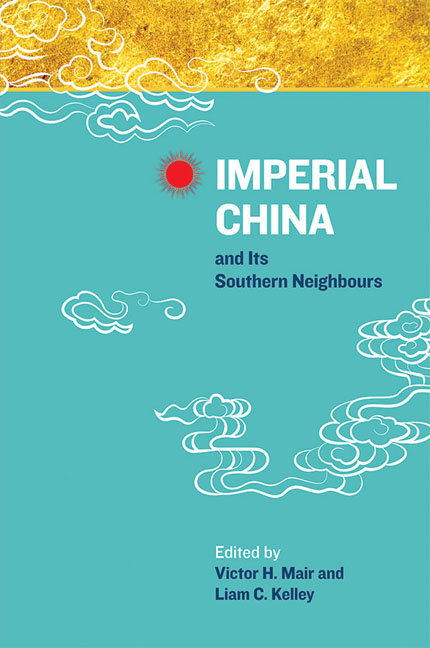Book contents
- Frontmatter
- Contents
- Preface
- The Contributors
- 1 Introduction: Imperial China Looking South
- 2 Layers of Meaning: Hairstyle and Yue Identity in Ancient Chinese Texts
- 3 Sinicization and Barbarization: Ancient State Formation at the Southern Edge of Sinitic Civilization
- 4 Clothes Make the Man: Body Culture and Ethnic Boundaries on the Lingnan Frontier in the Southern Song
- 5 What Makes a Chinese God? or, What Makes a God Chinese?
- 6 Dragon Boats and Serpent Prows: Naval Warfare and the Political Culture of China's Southern Borderlands
- 7 Inventing Traditions in Fifteenth-century Vietnam
- 8 Epidemics, Trade, and Local Worship in Vietnam, Leizhou Peninsula, and Hainan Island
- 9 Southeast Asian Primary Products and their Impact on Chinese Material Culture in the Tenth to Seventeenth Centuries
- 10 New Evidence on the History of Sino'arabic Relations: A Study of Yang Liangyao's Embassy to the Abbasid Caliphate
- 11 The Peacock's Gallbladder: An Example of Tibetan Influence in Late Imperial China
- 12 Transformation of the Yunnanese Community Along the Sino–burma Border During the Nineteenth and Early Twentieth Centuries
- 13 How the North Tried to Pacify the South Through Ritual Practices: On the Origins of the Guan Suo Opera in the Nineteenth Century
- 14 Realms Within Realms of Radiance, or, can Heaven Have Two Sons? Imperial China as Primus Inter Pares among Sino–pacific Mandala Polities
- Index
- Nalanda-Sriwijaya Series
1 - Introduction: Imperial China Looking South
Published online by Cambridge University Press: 06 January 2018
- Frontmatter
- Contents
- Preface
- The Contributors
- 1 Introduction: Imperial China Looking South
- 2 Layers of Meaning: Hairstyle and Yue Identity in Ancient Chinese Texts
- 3 Sinicization and Barbarization: Ancient State Formation at the Southern Edge of Sinitic Civilization
- 4 Clothes Make the Man: Body Culture and Ethnic Boundaries on the Lingnan Frontier in the Southern Song
- 5 What Makes a Chinese God? or, What Makes a God Chinese?
- 6 Dragon Boats and Serpent Prows: Naval Warfare and the Political Culture of China's Southern Borderlands
- 7 Inventing Traditions in Fifteenth-century Vietnam
- 8 Epidemics, Trade, and Local Worship in Vietnam, Leizhou Peninsula, and Hainan Island
- 9 Southeast Asian Primary Products and their Impact on Chinese Material Culture in the Tenth to Seventeenth Centuries
- 10 New Evidence on the History of Sino'arabic Relations: A Study of Yang Liangyao's Embassy to the Abbasid Caliphate
- 11 The Peacock's Gallbladder: An Example of Tibetan Influence in Late Imperial China
- 12 Transformation of the Yunnanese Community Along the Sino–burma Border During the Nineteenth and Early Twentieth Centuries
- 13 How the North Tried to Pacify the South Through Ritual Practices: On the Origins of the Guan Suo Opera in the Nineteenth Century
- 14 Realms Within Realms of Radiance, or, can Heaven Have Two Sons? Imperial China as Primus Inter Pares among Sino–pacific Mandala Polities
- Index
- Nalanda-Sriwijaya Series
Summary
Sixty years ago, a newly unified China was established, and its new leaders began to look southwards afresh. What they saw was a region that had been transformed by five centuries of a global maritime trade that eventually spawned several European empires. During that period, and especially in the nineteenth century, the earlier trading empires of the sixteenth to eighteenth centuries evolved into national empires as nationstates developed out of feudal and absolute monarchies. Some, like those of Britain and France, were greatly enriched and strengthened by the scientific and industrial revolutions and their large capitalist enterprises spread across the globe. By the first half of the twentieth century, however, the rival empires in Europe had turned on themselves, and this led them to fight two world wars. In the Asia that they had dominated since the early nineteenth century, their destructive conflicts produced many revolutionary changes, for example, the rise of a modern Japanese empire, the destruction of imperial China, new divisions on the Indian subcontinent and, at the end of the Second World War, the emergence of Southeast Asia as a selfconscious region with nationalist leaders who were dedicated to the task of building nation-states out of former colonial territories. The region's newfound self-awareness was enhanced by the common experience, for three and a half years during the Second World War, of having been under the dominance of a single, the Japanese, empire. This was the first time that the various kingdoms and ports and their peoples had ever come more or less under the control of one imperial power.
By the time China was reunified in 1949, some of the leaders of the countries to China's south were beginning to discover that they could together develop a distinctive identity for the region, and that it was in their interest to consider doing so as soon as they could. Spurred by anticolonial movements that embarked on the task of nation building, inspired by modern concepts of sovereignty, freedom, equality, and economic development, their leaders and scholars found new perspectives from which to examine the history of China's relations with the region. For a while, the new countries were divided by the Cold War.
- Type
- Chapter
- Information
- Imperial China and Its Southern Neighbours , pp. 1 - 15Publisher: ISEAS–Yusof Ishak InstitutePrint publication year: 2015



